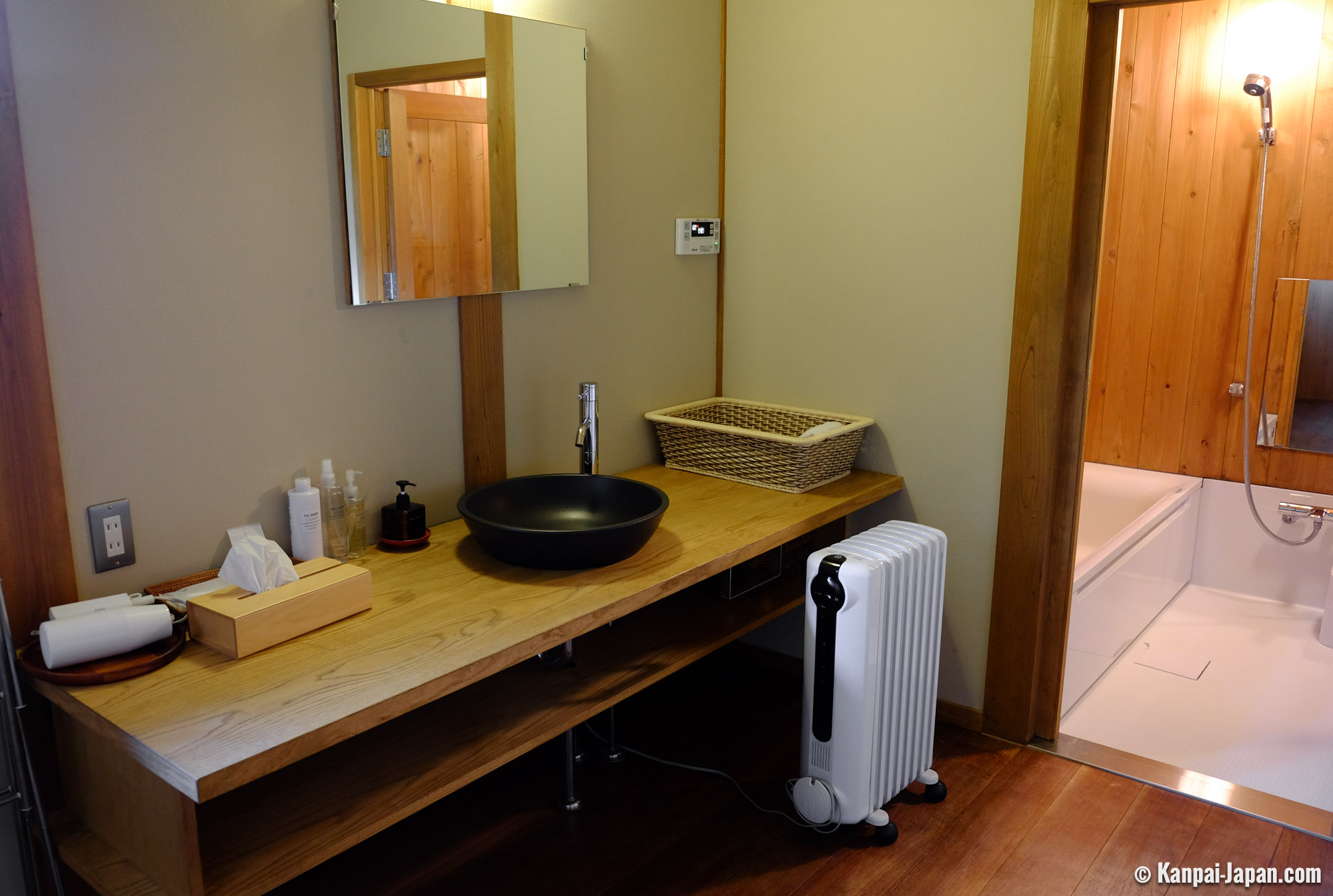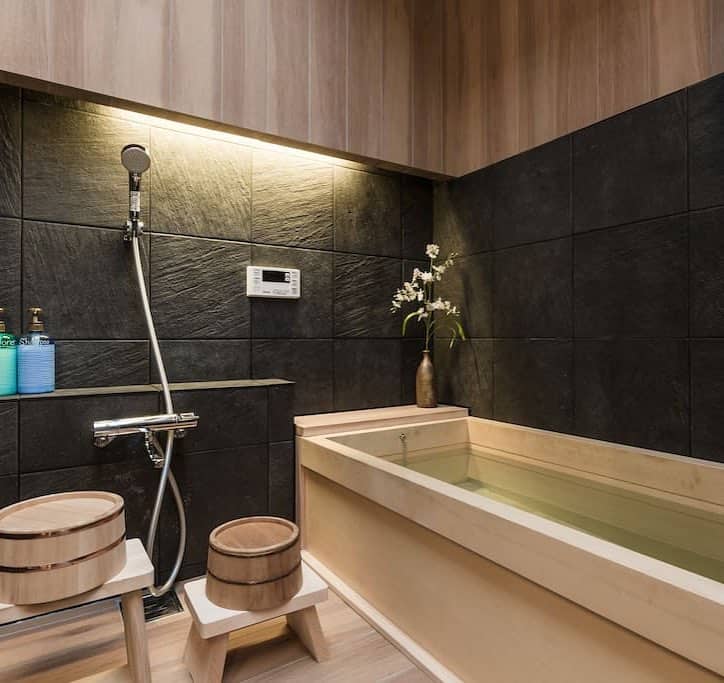The Essence of Traditional Japanese Style Bathrooms

Stepping into a traditional Japanese bathroom is like stepping back in time, a journey into a world where simplicity, functionality, and a deep respect for nature converge. These bathrooms are more than just spaces for hygiene; they are sanctuaries for relaxation and rejuvenation, embodying the core values of Japanese culture.
Historical and Cultural Significance, Traditional japanese style bathrooms
Traditional Japanese bathrooms, known as “furo,” have a rich history dating back centuries. Their origins are deeply intertwined with the Japanese appreciation for natural hot springs, known as “onsen.” These natural springs were believed to have healing properties and were considered sacred places for purification and relaxation. Over time, the practice of bathing in hot springs evolved into the tradition of home bathing, with furo becoming an integral part of Japanese homes.
Design Principles
Traditional Japanese bathrooms are characterized by a minimalist aesthetic and a focus on functionality. The core design principles that define these spaces are:
Simplicity and Minimalism
The primary design principle is simplicity. Traditional Japanese bathrooms are designed to be uncluttered and free from unnecessary embellishments. The focus is on creating a calm and serene environment that promotes relaxation.
Functionality and Efficiency
Traditional Japanese bathrooms are designed to be highly functional and efficient. The layout and design elements are carefully considered to optimize space and ensure a comfortable bathing experience.
Harmony with Nature
Traditional Japanese bathrooms often incorporate elements of nature, such as wood, stone, and natural light. These elements create a sense of connection to the outdoors and promote a sense of tranquility.
Key Elements
Several key elements contribute to the unique ambiance and functionality of traditional Japanese bathrooms:
The Bath Tub
The centerpiece of a traditional Japanese bathroom is the “ofuro,” a deep, rectangular bathtub typically made of wood or ceramic. The ofuro is designed for soaking rather than showering, allowing the body to relax and unwind.
The Wet and Dry Separation
Traditional Japanese bathrooms often feature a clear separation between the wet and dry areas. This separation helps to maintain a sense of order and hygiene, preventing the bathroom from feeling cluttered or cramped.
The Use of Natural Materials
Traditional Japanese bathrooms often incorporate natural materials such as wood, stone, and bamboo. These materials create a warm and inviting atmosphere, and they are also durable and long-lasting.
The Importance of Light
Natural light is an essential element in traditional Japanese bathrooms. The use of windows and skylights allows natural light to flood the space, creating a bright and airy atmosphere.
The Use of Traditional Japanese Aesthetics
Traditional Japanese bathrooms often incorporate traditional Japanese aesthetics, such as the use of shoji screens, tatami mats, and minimalist furniture. These elements create a sense of elegance and sophistication, adding to the overall ambiance of the bathroom.
Key Features of Traditional Japanese Style Bathrooms

Stepping into a traditional Japanese bathroom is like entering a sanctuary of tranquility and simplicity. The design prioritizes functionality and harmony with nature, creating a space that is both aesthetically pleasing and deeply relaxing.
Layout and Structure
The typical layout of a traditional Japanese bathroom features a distinct separation of spaces, each with its own purpose. The bathroom is often divided into two main areas: the wet area, which includes the furo (bathtub) and washbasin, and the dry area, which houses the toilet and sometimes a small dressing area.
Materials
The choice of materials in traditional Japanese bathrooms reflects a deep appreciation for natural beauty and durability.
- Wood: The use of wood is prevalent in traditional Japanese bathrooms. Cypress, known for its resistance to moisture and its aromatic qualities, is a popular choice for the walls, ceilings, and even the bathtub itself. Wood adds warmth and a sense of naturalness to the space.
- Stone: Stone, particularly granite and slate, is frequently incorporated into the design, often used for the floor and the washbasin. Stone provides a cool and calming touch, complementing the wood elements.
- Tatami Mats: While not always found in the wet area, tatami mats are often incorporated into the dry area of the bathroom, adding a touch of traditional elegance. Tatami mats are made from woven rush grass and provide a soft and comfortable surface for sitting or standing.
Furo (Bathtub)
The furo is the centerpiece of the traditional Japanese bathroom. It is a deep, rectangular tub, typically made of wood or ceramic, that is filled with hot water. The furo is not designed for showering, but rather for soaking in the hot water and relaxing.
- Design: The furo is often elevated slightly above the floor, creating a sense of privacy and seclusion. The rim of the furo is often wide and flat, providing a comfortable place to rest one’s head or arms.
- Function: Soaking in the hot water of the furo is considered a deeply relaxing and therapeutic experience in Japanese culture. It is believed to promote circulation, relieve muscle tension, and improve overall well-being.
Washbasin
The washbasin in a traditional Japanese bathroom is typically a simple, freestanding basin made of stone or ceramic. It is often placed near the furo, allowing for easy access while bathing. The washbasin is used for washing hands and face, and it may also have a small spout for rinsing the body.
Toilet
The toilet in a traditional Japanese bathroom is often a separate, enclosed space. Traditional Japanese toilets are typically squat toilets, which are believed to promote better digestion and elimination. However, modern Japanese bathrooms often incorporate western-style toilets with advanced features like heated seats and bidet functions.
Modern Interpretations of Traditional Japanese Style Bathrooms

The traditional Japanese bathroom, with its serene aesthetics and emphasis on ritualistic cleansing, has inspired a wave of modern design interpretations. Contemporary architects and designers are embracing the essence of these timeless spaces, seamlessly blending traditional elements with modern functionality and materials. This fusion creates bathrooms that are both visually captivating and deeply relaxing, offering a sanctuary for modern living.
Contemporary Materials and Technologies
Modern interpretations of traditional Japanese bathrooms often incorporate contemporary materials and technologies while maintaining the essence of traditional aesthetics. The use of natural materials like wood, stone, and bamboo adds a touch of warmth and tranquility, while modern fixtures and fittings provide functionality and convenience.
For example, the use of sleek, minimalist faucets and showers complements the simplicity of traditional Japanese design. Similarly, the incorporation of smart technologies like automated lighting and temperature control systems enhances the overall user experience without compromising the aesthetic integrity of the space.
Examples of Modern Bathrooms with Traditional Japanese Elements
Several contemporary bathroom designs demonstrate the successful integration of traditional Japanese elements with modern functionality.
- Minimalist Design: The use of clean lines, simple shapes, and a limited color palette evokes the tranquility and serenity of traditional Japanese design. The focus is on creating a sense of space and openness, with minimal clutter and distractions. This approach is often achieved by incorporating built-in storage solutions and concealed plumbing.
- Natural Materials: The incorporation of natural materials like wood, stone, and bamboo adds a touch of warmth and authenticity to the space. These materials create a calming and inviting atmosphere, reminiscent of traditional Japanese onsen (hot springs). For instance, a wooden soaking tub can be paired with a stone floor and bamboo accents to create a truly immersive experience.
- Open Layout: Traditional Japanese bathrooms often feature an open layout, with the shower and soaking tub integrated into the same space. This design approach promotes a sense of flow and continuity, while also maximizing the use of space. In modern interpretations, this concept can be adapted by incorporating a walk-in shower with a separate soaking tub, creating a seamless transition between the two areas.
- Zen Gardens: The concept of a Zen garden, with its focus on simplicity and contemplation, can be incorporated into modern bathroom designs. This can be achieved by creating a small, serene space within the bathroom, featuring a miniature rock garden, a water feature, or a simple arrangement of plants. This element adds a touch of tranquility and mindfulness to the space.